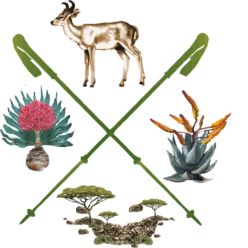For those birders who like to do their birding on foot, Klipriviersberg Nature Reserve has a wonderful mix of birds to discover. So far over 230 birds (see list) have been recorded with new surprises popping up all the time. The reserve has a good diversity of habitats.
The Bloubosspruit running north-south is straddled on either side by well wooded hills which changes to more montane grassland higher up the hill. The highest point is 1785m. (Almost the same height as Suikerbosrand). The southern side of the hills slope down to become more level and are covered in typical highveld grassland. At the southern most part of the reserve there is a small wetland along a tributory entering the Bloubosspruit. The woodlands are a mix of both broadleafed trees and acacia thornbush, the acacia being in the flatter areas.
In the valley on either side of the spruit look out for Jameson’s Firefinch, Red-
collared Widowbird, Brown-headed Tchagra, Red-thoated Wryneck; Black-throated Canary, Bronze Mannikin and Black-chested and Tawny-flanked Prinia and Black-throated Aplis. Brown-backed Honeybird, Bokmakierie, and Cape Robin are also regularly seen. The acacia supports a number of bushveld species, like Chestnut-vented Titbabbler, Cardinal Woodpecker and Pied Barbet, while Chinspot Batis and Ashy Tit are fairly regular visitors. And keep a look out for Verreaux’s Eagle overhead. Summer residents include Paradise Flycatcher, Willow Warbler and in some of the denser thickets, Icterine and Garden Warbler. Cuckoos include Red-chested, Diderick’s and less commonly Jacobin Cuckoo. Another resident is Steppe Buzzard.
In winter Fairy Flycacher moves through the wooded areas. Orange River Francolin are resident in the lower grasslands, which also support Zitting and Cloud Cisticola, Cape Longclaw, African Pipit and Rufous-naped Lark. Both Cape Rock Thrush and Sentinal Rock Thrush are sometimes seen at the top of the hill and Mountain Wheatear is a regular visitor.
The wetland is too small to offer permanent residence, but on any given day it is surprising to see what turns up. From White Stork to African Snipe to Green-backed Heron. Even Moorhen and Yellow-billed Duck seem to find enough water to stay around for awhile. The reed beds are alive with Red Bishops and Levailant’s Cistiola. African Reed Warbler can be heard warbling in the reeds as well. Pied and Wattled Starlings are often seen in the acacia alongside of the wetland. Hamerkop and African Black Duck are resident in the Bloubosspruit. Occasional visitors are Common Sandpiper and Three-banded Plover.
BIRD DATA
This is work in progress! But it is a start and hopefully with the contributions of volunteers it can grow quickly.
The bird data in the left hand column is arranged in the taxonomic order used by Roberts VI, and in the right column the birds are listed alphabetically using the family name first. To find a list of the birds in KNR, click on the link below; you will see the taxonomic list on the left and the alphabetic list on the right.
* indicates data updated
** indicates new additions
